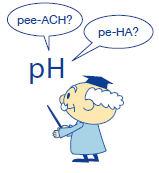Anecdotes About pH

Barbecue and beer is such a nice combination, but if a stomach can digest meat, what keeps it from digesting itself? The human stomach uses hydrochloric acid and enzymes such as pepsin to break down and digest proteins that have entered the stomach. Gastric mucus, besides providing lubrication, lines the stomach wall and protects it from being digested by the stomach's own gastric juices. The pH in our stomachs is usually around 2. If this pH is too low (strongly acidic), the stomach wall does become vulnerable. The health of our stomachs depends on pH.
Horses Run on Grass
|
There is a saying in England, home of thoroughbreds, "Horses run on grass," meaning high-quality grass is required in raising good thoroughbreds. The soil in Japan has acidity of pH 4.2-5.5, with a much lower content of calcium, phosphates and magnesium than that in England, where soil pH runs up to 6.5 or 7. So, wild grass in Japan is not conducive to raising horse with strong bones.
|
 |
Efforts have been continuously made to weaken the acidity of the soil by adding magnesium oxide lime and calcium carbonate. A thoroughbred born and raised in Japan may win a derby championship in England yet.
To Your Health! Viva, Alkaline!!
|
People are becoming more health-conscious. Healthy foods are very popular these days. By the way, many people misunderstand "acid food, alkaline food." This word does not refer to the pH of the food itself but to the pH of the food when absorbed by the body. For example, let's talk about lemons. The lemon itself is is quite acidic. However, it is called an alkaline food. Human bodies are most healthy when mildly alkaline. Therefore, we should eat not only acid foods such as meat and fish but also alkaline foods: FRUITS AND VEGETABLES !
|
 |
Is the Rain in Our Cities Acidic?
|
Have you ever experienced eye discomfort or holes in your pantyhose when it rained? You have acid rain to thank. Or, more accurately, its cause: SO2 and NOx belched out by factories and motor vehicles combine with water to form the sulfuric and nitric acid in acid rain. The pH of rain falling on the countryside with clean air will be around 6--mild acidity. However, in big cities, the pH of rain, especially when it first starts to fall, can run as high as 4.
|
 |

Acid rain
“Acid rain” has become a commonplace expression which most people know. However, it must also be said that, although they have probably heard of it, most people know little about acid rain.
Let us explain how rain is turned into acid rain.
The water in rivers and seas evaporates into the atmosphere, forming clouds, and comes back to the ground in the form of rain. In other words, rain is distilled water that is neutral (i.e. has a pH of 7), and its conductivity is close to that of pure water. However, if the atmosphere is polluted with sulfur dioxide (SO2) or nitrogen oxides (NOx), rain becomes oxidized by ozone (O3) or hydrogen peroxide (H2O2) to form H2SO4 or HNO3 before falling to the ground. You probably know the compounds H2SO4 and HNO3, since they are known respectively as sulfuric and nitric acid. The fact that these acids are actually falling from the sky is naturally a significant problem. If they fell directly on your head, they might cause you to go bald. Well, OK, although that is something of an exaggeration, it is probably better to avoid direct exposure to acid rain. (There is a report that the acid rain produced by the Sakurajima volcanic eruption had a pH of 2.5 and a conductivity of 1,640 μS/cm.)
There is no specific definition of acid rain. CO2 in the air dissolves in rain to produce mild acidity of pH 5.5 to 5.6, and if substances other than carbonic acid are absorbed in rain to give pH values lower than that, it is generally called acid rain. The pH alone, however, does not tell us the actual quantity of pollutants that the rain contains. Even if different acid rain has the same pH value of 5, it may have different conductivity, such as 50 μS/cm and 100 μS/cm. That with a conductivity of 100 μS/cm is obviously the more polluted. For rain of conductivity around 10 μS/cm, with a low level of pollution, stable pH measurement is difficult, and causes other than rain may give a pH of around 5. For these reasons, we recommend that conductivity be measured first, before measuring pH, in order to determine the level of pollution in the rain.
In Japan, an acid rain disaster occurred in 1973 which resulted in many people suffering from pain in their skin and eyes, with acid rain occurring particularly often in the form of light rain, such as drizzle.
The relationship between acid rain and the mass destruction of forests has drawn a great deal of attention, especially in Europe and North America, and today investigations are being undertaken worldwide on the chronic effects of acid rain.

Are Hydrangeas Nature's Litmus Paper?
As you know, the hydrangea is a flower of striking color variety--white, blue or pink. Did you know this color variation was related to the pH of the soil ? It is said that acid soil with a pH of 4.5 to 5 yields bright blue hydrangeas, but the color becomes close to red as the acidity becomes weak. Colorwise, this is just the opposite of litmus paper. You might call hydrangeas nature's litmus paper. And they're a lot nicer to look at than store-bought litmus paper !

Pronounced “pee-ACH” or “pe-HA”?
|
As it was a Danish chemist that first introduced the concept of pH, and since modern chemistry developed in Europe, pH was widely pronounced “pe-HA” in Japan before 1957, at which time it was incorporated into JIS and its pronunciation standardized to “pee-ACH.” Even today, however, both pronunciations are still common.
|
 |
|
|



|
